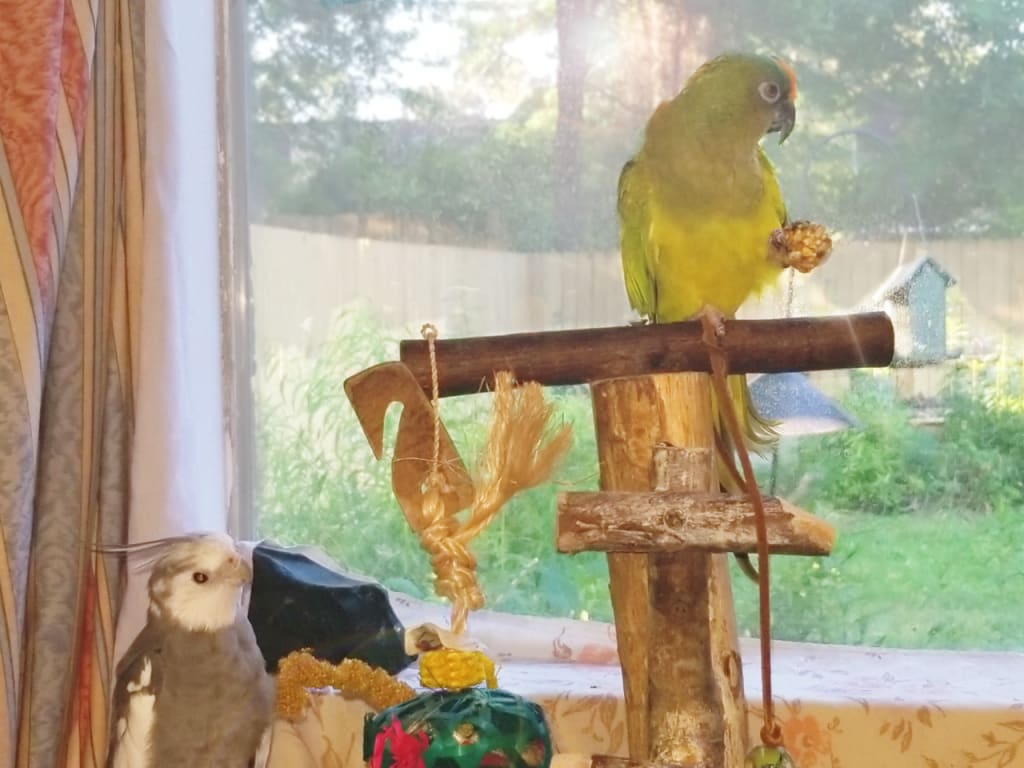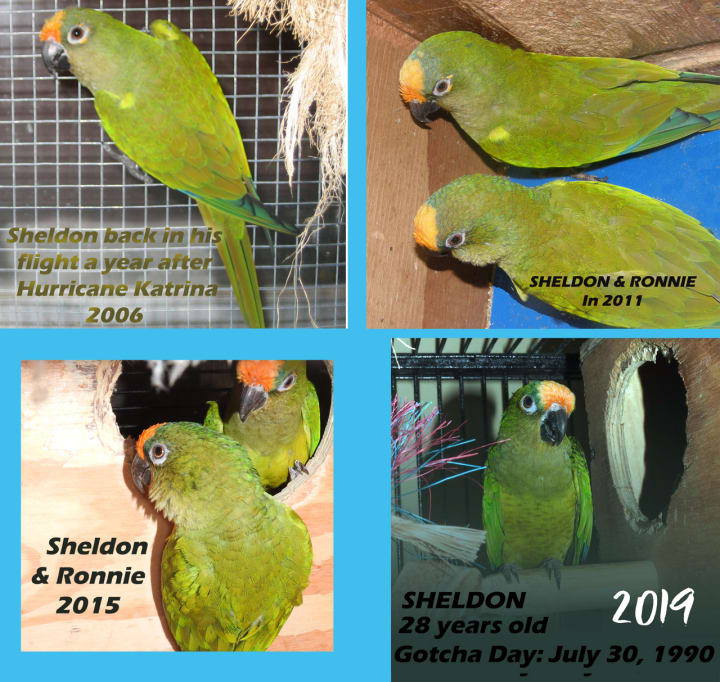A Very Old Parrot is a Treasure
In human years, these two Peach-fronted Conures lived to be 100

On January 29, 2021, my 30-year-old Peach-fronted Conure Sheldon passed away resting against my heart. He was weeks away from reaching age 31 — extreme old age for this species.
Two years earlier, on March 15, 2019, my Peach-front Courtney passed in the same way. He was exactly 29 years and 11 months old. I know this because I captive-raised him myself. His hatch date was April 16, 1990.
A meaningful day for me. I knew that breeding a baby parrot would teach me things I couldn’t know just from reading.
But I had no idea how much they would change me.
Impossible to express the emotions and meaning of three decades spent with a pet. And yet I feel as if I should share a few of my thoughts. This relationship will sneak up on you to prove far more meaningful than you ever imagined.

Even a small parrot is a commitment
Your relationship with a parrot is a long-term relationship. You’re used to hearing these words about big parrots. Cockatoos and macaws can live into their 80s. Maybe even longer.
For example, Cookie the Pink Cockatoo of Brookfield Zoo became a YouTube star in his 70s and lived to be 82:
Everyone knows these bigger parrot species live much longer than dogs and cats. However, fewer people realize that smaller parrots also outlive dogs and cats.
In the wild, a small conure like a Peach-fronted Parakeet has a life expectancy of 10 to 15 years. As prey animals, the day they get sick or injured is the day they are feasted upon by an alert bird of prey.
As pets, they have a life expectancy of 20 to 30 years. Although 20 years is often given as a conservative estimate of lifespan, I hear fairly often from other people who own Peach-fronted Conures in their late 20s or early 30s.
For example, the owner of this account occasionally updates about Peaches, who is now 32. If you're already familiar with Peach-fronts, you can pick up on the changes in this senior bird's voice:
Of course, you must give them the right care-- and giving them the right care starts with understanding their unique needs.
When I talk about Peach-fronts as a pet, I always call them conures and not parakeets — even though Peach-fronted Parakeet is the official English common name for the species Eupsittula aurea.
That’s because the word, “parakeet,” can refer to any parrot with a slim body and a long tail. Many people are more familiar with Australian parakeets like Budgerigars who have a completely different lifestyle, diet, and personality.
A conure managed like a budgie won’t last long.
It goes the other way too. For years I fed my conures soak-and-cook. Try feeding a budgie soak-and-cook, and see how far you get.
Know your bird. Know your bird’s species. Go the extra mile, because even your avian vet doesn’t know everything about every species.

Two different personalities
Both Sheldon and Courtney were aviary birds. Sheldon was an imported breeder purchased when he was already a young adult. Courtney was one of the birds I bred.
Since I had a small aviary and no intention of breeding birds for resale, I did not breed for long — just long enough to gain insight into the species and its behavior. I never had many birds. Each individual was an individual special to me.
As you might expect from aviary birds, their primary relationship was with their mates. Courtney was a classic BLT — Bossy Little Thing. He called me to give orders.
Chase that stupid cat out of my yard!
He had a special voice for that.
He also kept me informed of the comings and goings of the local Blue Jays, who like to imitate the local Red-shouldered Hawks.
Real Red-shouldered Hawks were, of course, observed in absolute frozen silence. (Don’t worry. My aviaries were predator and mosquito-free. The hawks could not get in.)

Sheldon too dutifully sat outside his mate’s nest box to survey the yard, but he kept quiet and watchful. He was ready to do something if something needed to be done, but he left Courtney in charge of the shouting.
Because I bred Courtney myself, I had trained him early to step onto a perch so I could move him into a travel cage for the usual adventures. Vet checks. Freeze advisories. Hurricane evacuations.
Sheldon kinda knew this stuff but he mostly made me chase him around. As a wild-caught bird, he probably had good reason not to be much impressed with the human race.
So they had very different personalities.
Each bird also had his mate, both captive-bred by me. When sitting in the aviary, I took great pleasure in watching the romance of the pairs — and the displays they put on to show off for the pair in the opposite flight.
All in all, my Peach-fronted Conures were easy-going drama-free residents of the aviary who brought joy to my life simply by going about their day and being themselves.

With age comes change
A parrot’s physical changes can sneak up on you. Those feathers hide a lot. At some point in their late twenties, their voices began to change. For lack of a better word, they were scratchier.
In later years, they also lost interest in flying. When all the climbing around their large flights began to look too effortful, I broke down the aviary to move them into smaller quarters.
However, they were still in fine feather, and it was something of a shock when the females died suddenly a few months apart, both at age 27. Although I’d discouraged them from breeding for years, they occasionally produced an egg or two, and Sheldon’s mate died of egg-binding.
My heart was broken, but I doubt my grief could match the grief of these protective senior birds who had lost their lifelong mates — and, with their mates, their sense of purpose.
Courtney’s mate passed first. Courtney himself had experienced a stroke a few years earlier, but he had recovered to the point where you really couldn’t tell. However, he did look older than the other three, and I wasn’t sure what to do.
For a few weeks, he grieved and did nothing except sulk in the nest box. I was so relieved on the day he finally agreed to step on his stick and come out to play.
From then on, the ice was broken, and I was able to let him spend several hours every day on the playpen with two rescue birds, an older white-faced Cockatiel and an outgoing Peach-faced Lovebird.

In his last months of life, Courtney became a little too frail for the stronger birds’ pushiness. By then, though, he was used to cuddling up to me — perching on my knee, arm, or the back of my chair. He also liked to sit in the window beside me to gaze out over his old backyard.
From time to time, he still sounded the alarm if a cat or a Blue Jay popped into view. His purpose was back. Now he was protecting not his mate but the entire office.
Because he was wild-caught, Sheldon was a special concern. Peach-fronts are pair-bond birds. They cannot be held in isolation. They need a special someone in their life. But I didn’t know if he could transfer his affections to anyone outside his own species.
When his mate passed, I hoped he’d be able to pal around with Courtney. But it turns out the old rivalries never really go away. The two senior males would talk to each other in soft tones as long as they were in their individual cages.
However, if I tried to put them together in the same cage, they’d fly at each other claws out. Uh-oh. These old boys had no business engaging in fisticuffs, but they still had that territorial instinct.
They could chat to each other, but they couldn’t be companions in any real sense.
Fortunately, in another way, Sheldon had mellowed with age. He no longer made me chase him around his flight. I thought he would forever be a touch-me-not where humans were concerned, but after a few months of grieving his mate’s death, he emerged from his shell.
To my surprise, he began to step up on request so I could take him around the house. Had this old dog learned a new trick?
Or had he known all along how to step on an arm or perch but simply didn’t want to?
Like Courtney before him, he began to wait expectantly for me to take him out to play in my office. He made friends with Boobear the Cockatiel. He cuddled with me.
We grew closer.

On the last day of his life, a very frail Courtney washed his face and then climbed into the window to look out on a sunny day. A short while later, he called to me in a soft voice, and I cuddled him to my heart.
He knows he is going, I thought.
So too with Sheldon.
They know but they do not fear.
I saw Sheldon one more time after her passed. He came to me in a dream:
“At the window’s ledge, he opens his wings, and up he goes, drifting up slowly, in lazy circles, a balloon riding an invisible thermal updraft.
I open my arms, and I’m right behind him.
Now we are two balloons, him a little ahead of me…”
At some point, words fail. How I miss them, my beautiful Peach-fronts.
.
Author's Note: A version of this story originally appeared in Found in My Journal, a Medium publication. If you like me making these stories available to Vocal readers, please tap the <3 button to let me know. I also accept tips.
Under my pet pen name, I’m a former writer for American Cage-Bird Magazine and Bird Talk. Those publications are long gone, but if you’re a Peach-fronted Conure owner or thinking about becoming one, you can read in-depth information about Peach-fronted Conures in my paperback available from Amazon US and Amazon UK.
You might also like these Vocal stories about my senior birds:
About the Creator
Amethyst Qu
Seeker, traveler, birder, crystal collector, photographer. I sometimes visit the mysterious side of life. Author of "The Moldavite Message" and "Crystal Magick, Meditation, and Manifestation."
https://linktr.ee/amethystqu






Comments
There are no comments for this story
Be the first to respond and start the conversation.